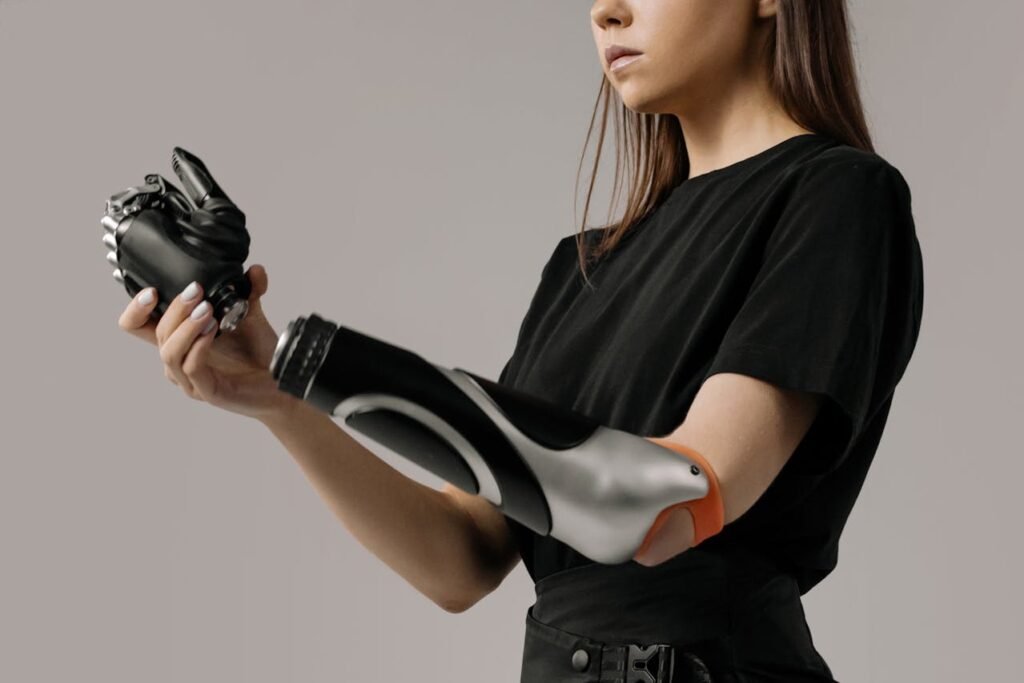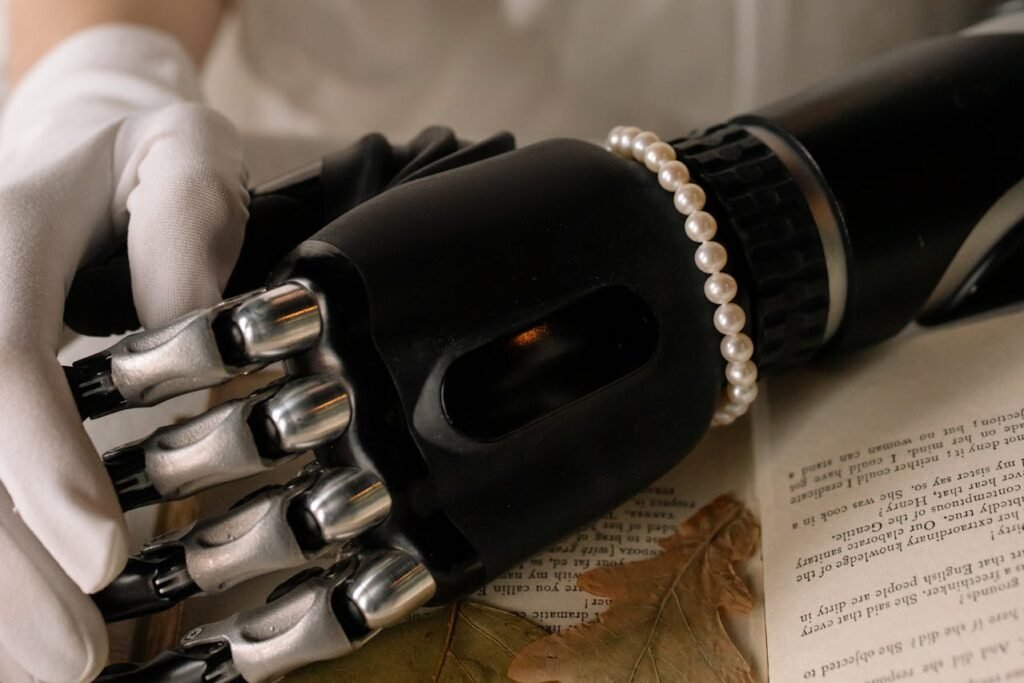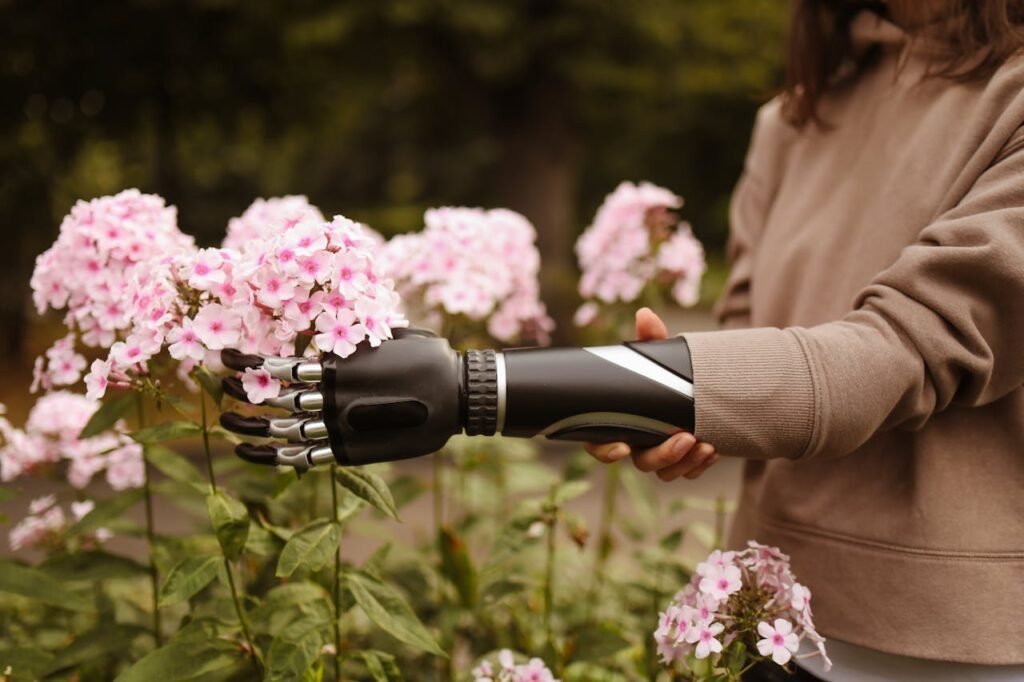For many Indian women, jewelry isn’t just an accessory—it’s a part of identity, culture, and everyday beauty. From the soft jingle of bangles to the delicate touch of mehendi, these details express tradition, personality, and emotion. But for women using a prosthetic hand, wearing these symbols can sometimes feel complicated.
The truth is, it doesn’t have to be. With the right techniques and a bit of creativity, prosthetic users can enjoy bangles, bracelets, rings, and even mehendi art comfortably and beautifully. The key lies in understanding how your prosthetic works, how jewelry interacts with its materials, and how small adjustments can make a big difference.
At Robobionics, we’ve met countless women who want to enjoy traditional customs and modern style with equal ease. We’ve learned from their experiences, challenges, and inspiring innovations. This guide brings together practical advice, design insights, and emotional encouragement to help you express yourself freely—because no prosthetic should ever limit your sense of beauty.
Understanding Jewelry Compatibility with Prosthetic Hands
How Jewelry and Prosthetics Interact

Wearing jewellry with a prosthetic hand is not just about appearance—it’s about fit, movement, and comfort. A prosthetic hand is made of materials like silicone, carbon fiber, or lightweight polymers, which respond differently than human skin.
These surfaces can either grip jewellry too tightly or allow it to slide off easily. The key is understanding how your prosthetic’s texture and flexibility affect accessories such as bangles, rings, or bracelets.
When matched correctly, jewelry can rest naturally on the prosthetic without damage or discomfort. The goal is to make it feel effortless, not forced.
The Role of Material and Finish
Different prosthetic finishes interact uniquely with jewelry. A matte silicone glove provides better friction for lightweight ornaments, while a glossy surface may make them slip.
Women who wear metallic bangles or cuffs should ensure the inner surface of the jewelry is smooth to prevent scratching the prosthetic glove. Even though silicone is durable, constant friction from sharp edges can cause wear over time.
Choosing accessories made with smooth alloys, resin, or coated metals helps maintain both comfort and aesthetics.
Understanding the Shape and Size of Your Prosthetic
Each prosthetic hand has its own contour, width, and wrist shape. Standard jewelry sizes don’t always fit perfectly. A slightly larger bangle or adjustable bracelet is often easier to wear without strain.
Some prosthetics have movable joints or flexible wrists. These designs allow jewelry to slide on naturally, while fixed models may require different techniques, such as using open bangles or adjustable clasps.
Your prosthetist can even advise on the safest pressure points for wearing ornaments without affecting grip strength or device balance.
Comfort Before Appearance
While jewelry is beautiful, comfort should always come first. A bangle that’s too tight can stretch or deform silicone. Similarly, heavy bracelets may throw off the balance of lighter prosthetic hands.
The best approach is to start small. Try one or two lightweight pieces to test how your prosthetic responds before wearing more. Once you know the right fit, you can gradually experiment with other designs.
At Robobionics, we often suggest choosing jewelry that complements both the prosthetic and the person. Beauty should enhance your comfort, not compromise it.
Balancing Movement and Adornment
A prosthetic hand is meant for motion. Jewelry should never interfere with its mechanics. Rings shouldn’t block finger joints, and bracelets shouldn’t hinder wrist rotation.
Low-profile jewelry that hugs the wrist or fingers tends to work best. Avoid overly loose ornaments that swing while walking—they can feel distracting or even damage the prosthetic surface.
Think of jewelry as part of your movement, not an addition to it. It should follow your gestures, not limit them.
When Tradition Meets Technology
In Indian culture, jewelry carries emotion—wedding bangles, festival adornments, or heirloom rings all tell stories. Modern prosthetics make it possible to continue these traditions without compromise.
The secret lies in adaptation. A few minor adjustments in jewelry design—like elastic inserts in bangles or flexible bracelets—can make traditional ornaments compatible with modern prosthetics.
This blending of culture and technology allows women to preserve customs while embracing innovation.
Choosing the Right Hand for Adornment
Many women prefer wearing jewelry on their natural hand and leaving the prosthetic plain. Others love decorating both equally. There’s no rule—just personal comfort and expression.
If your prosthetic is on your dominant hand, lightweight jewelry ensures better balance. If it’s on your non-dominant hand, you can experiment more freely with traditional or heavier designs.
Some women use the prosthetic as an artistic canvas—choosing bold jewelry or painted mehendi to celebrate resilience and individuality.
Practical Techniques for Wearing Bangles, Bracelets, and Rings on a Prosthetic Hand
Wearing Bangles the Right Way

Bangles are a symbol of grace and tradition, but sliding them over a prosthetic hand needs a little technique. The most important thing is to avoid forcing them. Applying pressure can damage both the bangle and the prosthetic’s outer glove.
The easiest method is to use open-ended bangles or ones with flexible hinges. These allow you to gently place them around the wrist instead of pushing them through the hand. Many jewelers today design such bangles that close securely yet open easily, making them perfect for prosthetic users.
If you prefer traditional closed bangles, try slipping them over a protective sleeve or soft cloth to reduce friction. Silicone prosthetics can grip surfaces tightly, so a smooth layer between your prosthetic and the bangle helps it glide on naturally.
Choosing the Right Bangle Size and Shape
Bangles that are slightly larger than your wrist circumference are ideal. A tight fit may stretch the silicone covering, while an overly loose bangle may slide uncontrollably and feel heavy.
You can measure the wrist section of your prosthetic using a tailor’s tape, then select bangles one or two millimeters wider. This ensures they sit comfortably without slipping.
Flat-edged bangles are also gentler on prosthetic surfaces than sharp or angular designs. If you love intricate jewelry, choose styles with smooth inner finishes and rounded engravings.
Balancing Traditional and Modern Designs
Traditional glass bangles look beautiful, but they can break easily and scratch silicone. Instead, consider alternatives like resin, acrylic, or lightweight metal bangles. These materials mimic traditional looks but are safer and more practical.
If you want to wear glass bangles for special occasions, wear them on your natural hand and match similar-looking metal bangles on the prosthetic side. This creates symmetry without risk.
For weddings or festivals, customized bangles with clasps can be made to fit around your prosthetic wrist comfortably. They look just as elegant and stay in place without any force.
Handling Bracelets and Kada
Bracelets and kada often feel easier to manage than bangles. Their open-ended structure gives flexibility and comfort. Many Indian women with prosthetics prefer bracelets because they can adjust the fit easily and remove them without assistance.
Magnetic lock bracelets and screw-type kada are especially useful. They allow secure fastening without needing fine finger movements. A small adjustment tool can help lock or unlock them with one hand.
When choosing a bracelet, check that its inner metal doesn’t have sharp corners. Smooth interiors protect the silicone glove and prevent discoloration over time.
Matching Jewelry with Socket Design
Low-profile prosthetic sockets, which are slimmer near the wrist, make jewelry fitting much easier. You can slide bangles or bracelets over them naturally, especially if they have a slightly elastic or hinged design.
If your prosthetic has a wider or mechanical wrist, your prosthetist can attach a cosmetic wrist cover made of soft silicone to create a smoother transition for jewelry. This allows bangles to sit comfortably and look natural.
Matching socket design with jewelry style ensures that both form and function complement each other.
Wearing Rings Safely
Rings are small, but they need special care when worn on prosthetic fingers. Silicone gloves are soft yet delicate, and sliding rings directly can cause wear if not done carefully.
Always choose rings that are slightly larger than your prosthetic finger diameter. Adjustable rings work best—they allow you to tighten them slightly for grip without stretching the glove.
Avoid twisting rings onto your prosthetic. Instead, use a gentle sliding motion. If the glove surface is dry, apply a drop of baby oil or moisturizer to ease movement. Once the ring is in place, wipe off any excess to maintain grip.
How to Prevent Damage from Rings
Metal rings can react with silicone over time, leaving faint stains or dull marks. To avoid this, choose coated or hypoallergenic metals like stainless steel, platinum, or rhodium-plated alloys.
You can also add a small transparent barrier—like a clear medical-grade film—beneath the ring to protect the glove. It remains invisible but keeps your prosthetic in good shape.
If your prosthetic has flexible finger joints, ensure the ring sits above the joint to prevent interference with motion. Placement matters as much as fit.
Coordinating Jewelry for a Balanced Look
One subtle trick for symmetry is coordinating jewelry between both hands. You can wear heavier bangles or multiple bracelets on your natural hand and keep fewer, lighter pieces on the prosthetic.
This creates balance both visually and physically. You’ll still enjoy the complete look of traditional adornment without feeling uneven.
Some women choose complementary jewelry instead of identical pieces. For instance, if you wear gold bangles on one hand, you could wear a delicate gold bracelet or kada on the prosthetic side. This softens the overall appearance and keeps the look elegant.
Jewelry Weight and Prosthetic Balance
Lightweight jewelry is always the better choice for prosthetic users. Heavy ornaments can alter balance, especially on myoelectric or mechanical hands. The weight distribution might make wrist control harder during extended wear.
Modern jewelry makers now offer lightweight gold, silver, and imitation options that maintain the same sparkle without bulk. These pieces are ideal for all-day wear and special occasions alike.
Before buying any jewelry, hold it briefly while wearing your prosthetic. If it feels natural and doesn’t shift your posture, it’s a perfect match.
Adapting Traditional Jewelry for Modern Needs
Indian jewelers are becoming increasingly aware of prosthetic wearers’ needs. Many now offer design modifications—hinged bangles, wider rings, and adjustable bracelets. These look exactly like traditional pieces but function with ease and safety.
You can even request custom fittings where your jeweler takes measurements from your prosthetic wrist. This ensures a snug but gentle fit.
Such adaptations allow you to preserve your traditions while embracing new technology. The combination of craftsmanship and customization gives both beauty and comfort.
Jewelry for Daily vs. Occasional Wear
Everyday jewelry should be light, simple, and easy to remove. Bangles or bracelets with soft clasps and minimal decoration are ideal for regular use.
For special events like weddings or festivals, you can safely wear heavier pieces for shorter durations. The key is to remove them gently afterward and clean both the jewelry and the prosthetic glove to avoid residue buildup.
Alternating between light and ornate pieces helps keep your prosthetic glove clean and your accessories lasting longer.
Caring for the Prosthetic After Wearing Jewelry
After removing jewelry, always inspect the prosthetic glove for any marks or friction spots. A quick wipe with a soft damp cloth removes dust and oil left behind by metal surfaces.
If you notice scratches or faint stains, apply a silicone-safe cleaning solution or speak to your prosthetist. Avoid harsh cleaners—they can dull the glove’s finish.
A simple routine of cleaning after jewelry use keeps your prosthetic looking new and extends the life of both the glove and the ornaments.
Emotional Connection with Jewelry
For many women, jewelry carries emotional meaning—especially wedding bangles, family heirlooms, or gifted rings. Being able to wear these pieces again after limb loss can be profoundly healing.
It’s not just decoration—it’s a reminder of identity and continuity. Relearning to wear jewelry on a prosthetic hand reconnects you with your past and helps you move forward with grace.
That sense of normalcy is deeply empowering. You’re not adapting to limitations—you’re adapting the world to fit you.
Applying Mehendi, Styling Accessories, Cultural Adaptation, and Emotional Empowerment for Women with Prosthetic Hands
Mehendi on a Prosthetic Hand – A Symbol Reimagined

Mehendi is more than body art—it’s celebration, culture, and emotion. For Indian women, it carries the joy of festivals, weddings, and milestones. Many women with prosthetic hands worry they might not be able to enjoy this tradition again. But the truth is, they can.
Silicone prosthetic gloves can hold mehendi designs beautifully with the right technique. While the color doesn’t stain like natural skin, intricate designs can be applied temporarily using safe, cosmetic-grade mehendi or removable dyes. This allows you to enjoy the festive look without causing damage to the prosthetic.
The design stays visible for a few days and can be gently cleaned away with a soft cloth and mild soap. It’s not about replication—it’s about representation. Mehendi on a prosthetic symbolizes adaptation and resilience, blending modern prosthetics with ancient tradition.
Techniques for Applying Mehendi on Silicone
Before applying mehendi, ensure your prosthetic glove is clean and dry. Avoid using oil or lotion beforehand, as it prevents the mehendi paste from adhering properly.
Use a thin, smooth layer of cosmetic mehendi instead of natural henna, which may contain acidic ingredients. Cosmetic versions are designed for synthetic surfaces, safe, and easy to remove.
You can apply traditional floral or geometric patterns using cones just like normal mehendi. Once applied, let it dry naturally for an hour or two. Avoid rubbing or folding the prosthetic during this time to preserve design clarity.
When ready to remove, simply wipe with a soft wet cloth. The result is an elegant, festive design that enhances your look and spirit without any damage.
Temporary Mehendi Alternatives
For those who prefer less mess or faster application, temporary mehendi stickers or transfers work perfectly. These designs can be chosen to match your natural hand, creating symmetry between both hands.
Modern stickers are waterproof and come in various shades of brown and red to imitate real mehendi. You can apply them in minutes and remove them without residue.
This quick alternative allows women with prosthetics to participate in cultural traditions with the same excitement, even when time or practicality doesn’t allow full mehendi application.
Cultural Meaning of Wearing Mehendi on a Prosthetic
There’s deep symbolism in decorating a prosthetic hand with mehendi. It turns something functional into something expressive. For many women, it becomes a quiet celebration of identity and adaptability.
At weddings, it allows the bride to honor tradition while embracing technology. For festivals, it’s a gesture of joy—a way to show that beauty has no boundaries.
Women often tell us that applying mehendi again after amputation brings tears of happiness. It marks not loss, but continuity. A prosthetic hand carrying mehendi designs becomes a symbol of resilience and grace.
Styling Jewelry and Mehendi Together
When mehendi and jewelry come together, they tell a story of confidence. You can use lighter-colored mehendi on a prosthetic hand to create contrast against metal or colorful bangles.
Since the prosthetic surface doesn’t absorb pigment deeply, the mehendi looks fresh longer. Combining it with gold or silver jewelry highlights the design beautifully under light.
If you wear a silicone glove matched to your skin tone, choose jewelry in warm metals for harmony. For fairer tones, rose gold or copper jewelry gives a soft, balanced glow that complements both mehendi and fabric.
Accessorizing Beyond Jewelry
Adorning a prosthetic isn’t limited to traditional jewelry. You can experiment with anklet-style chains around the wrist, delicate fabric wraps, or even gemstone-studded cuffs. These add sparkle while keeping comfort in mind.
Some women attach detachable rings or charm chains that connect bracelets and rings, creating the illusion of full hand ornamentation. Others prefer soft thread or beaded bracelets that can be tied rather than slipped on.
Creativity has no limits here—your prosthetic can become a part of your fashion statement rather than something to conceal.
Coordinating Accessories for Saree, Salwar, and Modern Wear
The beauty of Indian attire lies in its versatility. Whether it’s the shimmer of a saree or the flow of a salwar, your accessories should complement the outfit’s rhythm.
For sarees, lighter bangles paired with slim bracelets maintain elegance without overwhelming the drape. If you wear heavy traditional jewelry, balance it with simpler designs on the prosthetic side for visual symmetry.
Salwar suits pair well with kada or open-ended bangles that stay secure even with movement. For modern wear—like kurtis, dresses, or formal shirts—minimalist jewelry, thin chains, or textured cuffs blend effortlessly.
Your goal is not to match exactly, but to harmonize—creating balance between both hands and your overall appearance.
Making Jewelry Work with Festivals and Rituals
Festivals in India often include rituals involving flowers, colors, or holy water. It’s important to protect your prosthetic during these times without missing out on the fun.
If applying turmeric, gulal, or flower oils, cover your prosthetic with a transparent glove or removable cover. This prevents staining or residue on silicone surfaces.
Once rituals are complete, remove the cover and clean your prosthetic gently. You can then wear your bangles, bracelets, or rings again for the celebrations without any worry.
Participation in rituals should never feel restricted—just adapted with care.
Designing Jewelry for a Prosthetic Hand
Many jewelers now collaborate with prosthetic users to design custom ornaments. These pieces are tailored to fit perfectly over silicone gloves or carbon-fiber sockets.
Custom designs often include open bands, adjustable clasps, or lightweight alloys that are easier to wear. The jewelry sits naturally, without extra pressure or imbalance.
Some women even personalize their prosthetic hand with symbolic pieces—like engraved bangles or charm bracelets that represent milestones. These pieces make the prosthetic uniquely theirs, transforming it from a tool into a treasure.
Embracing Cultural Rituals with Pride
In India, beauty rituals like mehendi, bangles, and jewelry carry emotional weight. They’re tied to celebrations of love, new beginnings, and identity. For women using prosthetics, continuing these traditions reinforces belonging and self-respect.
At weddings, festivals, or family gatherings, your prosthetic doesn’t need to stay hidden. The more you treat it as part of your identity, the more natural it feels to others too.
Adapting these rituals shows that tradition evolves with time—and that grace has nothing to do with perfection.
Emotional Connection Through Adornment
Wearing jewelry and mehendi is emotional—it’s about feeling complete. For women who have lost a limb, rediscovering the joy of self-decoration can be profoundly healing.
These small acts—slipping on bangles, painting designs, choosing colors—bring back familiarity. They restore a sense of routine and joy that’s easy to overlook after limb loss.
Each ornament becomes a symbol of self-expression, not concealment. It tells the world: “I’m still me. I’m still beautiful.”
Overcoming Social Anxiety
Many women initially hesitate to wear visible jewelry or mehendi on their prosthetic hand in public. They fear being stared at or questioned. But with time and confidence, most realize that self-expression often changes how others perceive them.
When you embrace your prosthetic with pride and style, it becomes a story of strength, not difference. People notice confidence far more than they notice the device.
You inspire others simply by being comfortable in your own skin—and that confidence can transform social spaces into supportive ones.
Building Confidence Gradually
If you’re new to prosthetic use, start small. Wear a light bracelet or single ring first, then add more as you grow comfortable. Try mehendi designs during small gatherings before festivals.
This gradual approach helps you develop familiarity and trust in your prosthetic. It also gives you time to discover your own aesthetic preferences.
Every step you take—whether it’s wearing jewelry for an event or applying mehendi for the first time—is progress toward emotional freedom.
The Role of Family and Support
Family support makes adaptation smoother. Encourage loved ones to understand how your prosthetic works and how delicate it can be. This awareness prevents accidental strain during jewelry application or festivities.
Many women say that when their families celebrate their effort to embrace tradition again, it strengthens their self-image. Supportive surroundings turn adaptation into shared joy.
At Robobionics, we’ve seen mothers teaching daughters how to wear bangles again, sisters applying mehendi together, and friends helping fit jewelry before a wedding. These moments redefine beauty and belonging.
Photography, Art, and Representation
One beautiful trend among prosthetic users is reclaiming visibility through photography and art. Women showcase their prosthetic hands adorned with bangles, henna, or jewelry on social media. These images not only inspire others but also normalize the blend of prosthetics and tradition.
Seeing these expressions changes perspectives. What once symbolized limitation becomes a symbol of artistry. Women redefine beauty on their terms—modern, confident, and deeply rooted in culture.
A Celebration of Identity
Jewelry and mehendi are not just decorative—they’re declarations of identity. They celebrate who you are and where you come from.
Wearing them on a prosthetic hand is a powerful act of self-love. It acknowledges that your beauty hasn’t changed; it has evolved. It’s an expression of how strength and grace can exist together, hand in hand.
At Robobionics, we’ve learned from every woman who chose to adorn her prosthetic. Each one reminds us that adaptation isn’t surrender—it’s transformation.
Looking Ahead – The Future of Inclusive Beauty
As technology evolves, so does fashion. Future prosthetic gloves will allow even more creative expression—interchangeable surfaces for jewelry attachment, color customization, and mehendi-friendly coatings.
Indian manufacturers are already exploring designs that integrate jewelry seamlessly into prosthetic surfaces—creating built-in bangles or decorative sleeves that feel both functional and ornamental.
This merging of fashion, culture, and innovation ensures that no woman will ever have to choose between style and practicality again.
Final Thoughts
Bangles, mehendi, and jewelry are timeless symbols of Indian femininity. For women with prosthetic hands, these traditions hold even deeper meaning—they represent resilience, creativity, and pride.
Every bangle slipped on, every mehendi design drawn, and every piece of jewelry worn is an act of defiance against limitation. It’s a statement that beauty adapts, evolves, and thrives.
At Robobionics, we believe that prosthetics should never dim expression—they should empower it. Whether it’s a festival, a wedding, or a quiet moment of self-admiration, your prosthetic can be a part of every celebration.
Because grace isn’t defined by what’s natural—it’s defined by how you carry what’s yours with confidence, warmth, and joy.



